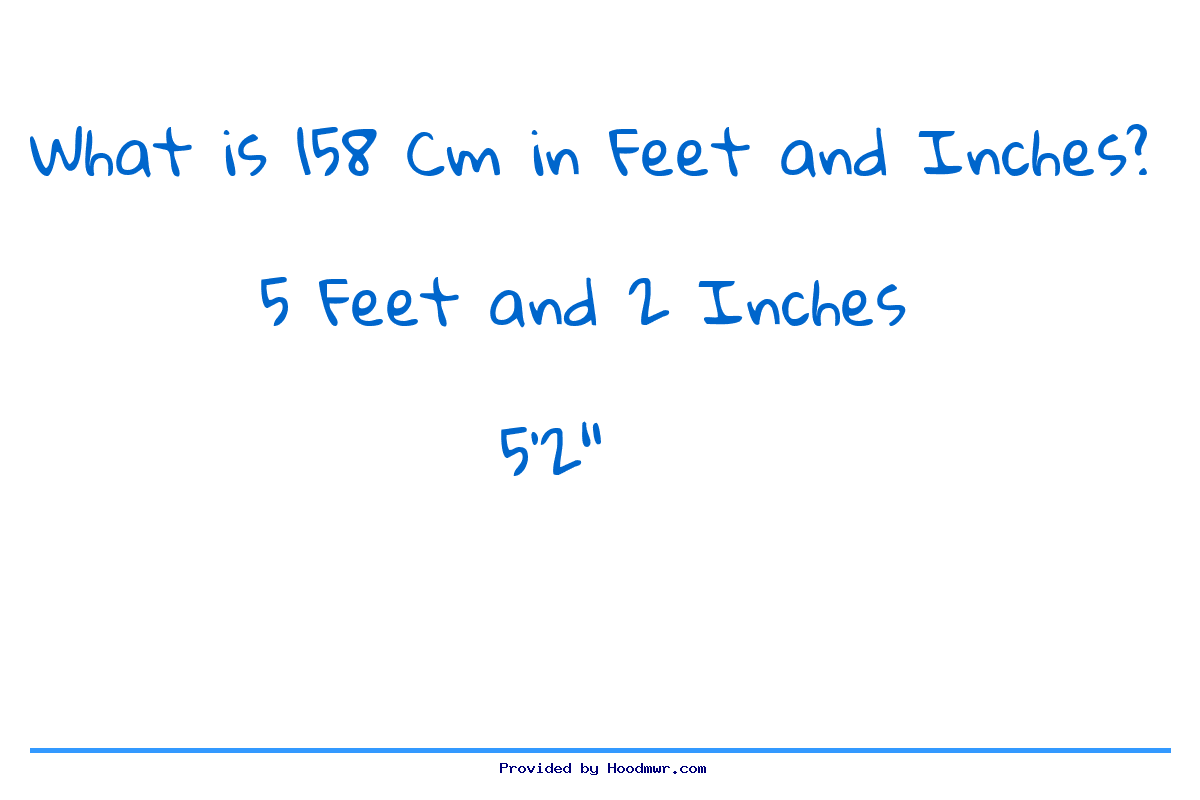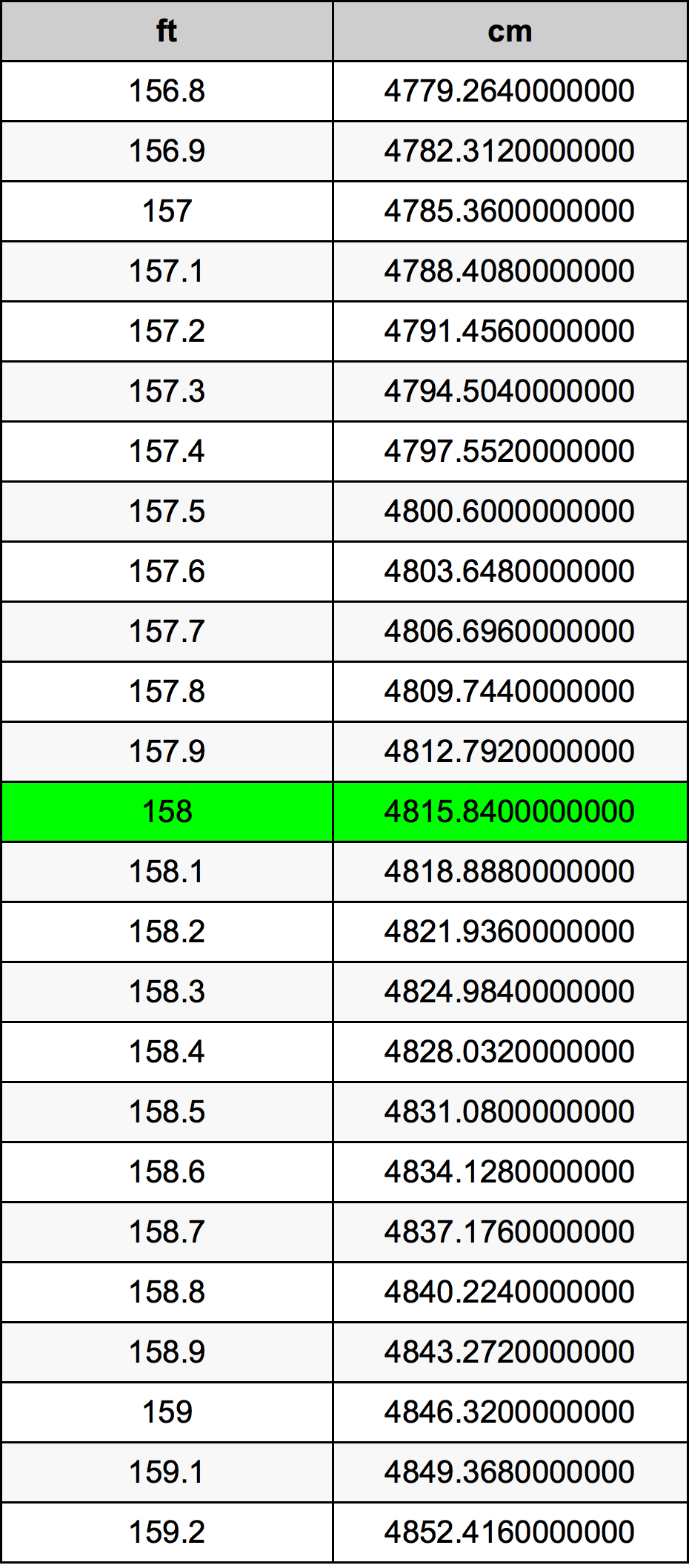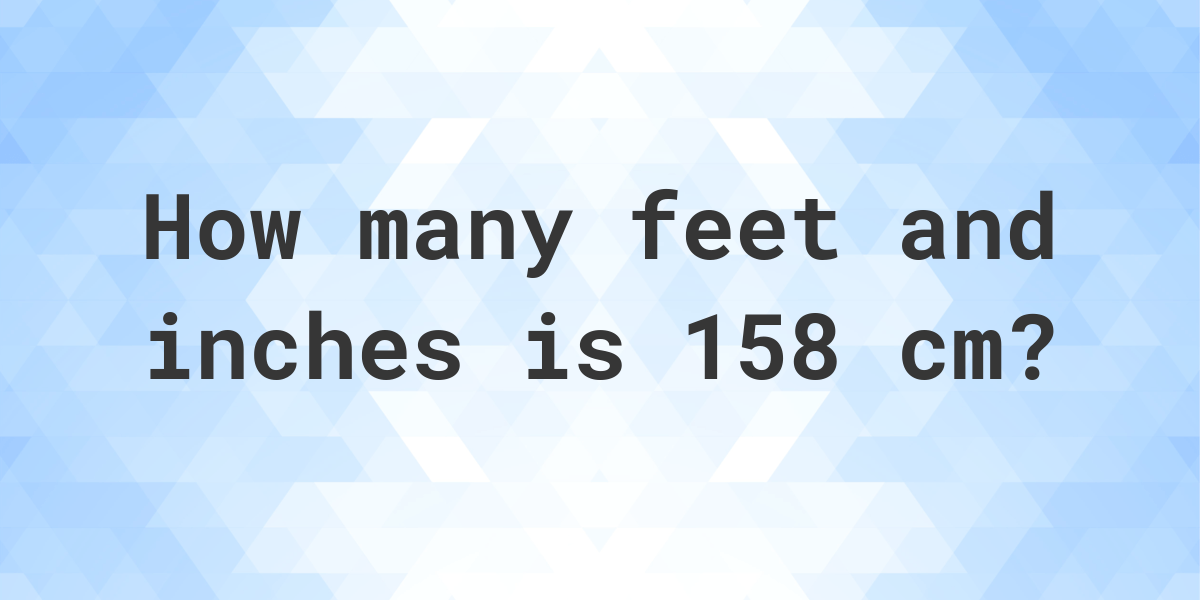Ever wondered exactly how tall 158cm translates to in feet? Understanding this conversion is crucial for various reasons, from medical records to travel documentation and even online dating profiles.
The metric system, with its centimeters and meters, reigns supreme in many parts of the world. However, the imperial system, using feet and inches, remains prevalent in countries like the United States. Therefore, converting between these systems is a common necessity. The straightforward calculation reveals that 158 centimeters is approximately equal to 5 feet and 2.2 inches. This conversion is achieved by dividing the centimeter measurement by 2.54 (the number of centimeters in an inch) and then dividing the resulting inch measurement by 12 (the number of inches in a foot). Understanding this process helps to visualize and contextualize height measurements in different units. More specifically, 158 cm is equal to 62.2 inches. Dividing 62.2 inches by 12 inches/foot gives 5.18 feet. The 5 represents the whole feet, and the 0.18 is the remaining fraction of a foot, which when multiplied by 12 gives the inches. Thus 0.18 * 12 = 2.2 inches. This finalizes the conversion to 5 feet and 2.2 inches.
Consider its practical applications. A doctor in the United States receiving medical records from a European colleague needs to understand a patient's height documented in centimeters. Similarly, someone applying for a visa to a country using the imperial system might need to convert their height for the application form. Even online, understanding this conversion can be helpful when assessing compatibility with someone whose profile displays height in a different unit. It simplifies understanding in scenarios involving fashion, interior design, and sports, where measurements play a key role.
- Access Your Raspberry Pi Remotely Guide For Windows More
- Corinna Jaggers Story A Look At Mick Jaggers Daughter Family Life
Moreover, the slight discrepancy of 0.2 inches is worth noting. While often rounded to 5 feet 2 inches, the precise conversion yields 5 feet 2.2 inches. For certain applications where precision is paramount, retaining the decimal value is essential. Imagine a tailor needing accurate measurements for a custom-made suit or a researcher collecting anthropometric data; these small fractions become significant. Its also worth noting that online calculators, readily available, automate this conversion, eliminating the need for manual calculation.
The context also influences the interpretation. For instance, 158cm is considered an average height for women in many parts of the world. However, in other regions, it might be slightly above or below average. When interpreting height measurements, cultural and regional variations in average height should be considered to provide a more complete picture. Comparing this measurement to the average height in different populations reveals interesting insights into human variation. Furthermore, self-perception of height also plays a role. Some individuals may perceive themselves as taller or shorter than their actual height, influenced by factors such as body image and social comparison.
In conclusion, while the conversion from 158cm to feet (approximately 5 feet 2.2 inches) may seem straightforward, its significance extends across various contexts. Whether it's for medical, professional, or personal reasons, understanding this conversion bridges the gap between measurement systems and fosters clearer communication. It is, therefore, a valuable piece of information to have in one's arsenal of general knowledge. The ability to navigate between different measurement systems is a testament to adaptability and enhances one's capacity to interact effectively in a globalized world.
- Raspberry Pi Ssh Remote Access Free Download Guide
- Unlock Remote Access Remoteiot Ssh For Raspberry Pi Free Download
Think about applying for a job where physical requirements are listed in feet and inches. Knowing how your height in centimeters translates ensures you meet the criteria. Or consider online shopping for clothing, where size charts often include measurements in both systems. Understanding the conversion prevents ordering the wrong size and ensures a proper fit. In the world of sports, where height can be a significant advantage, knowing how you measure up in both centimeters and feet can be crucial. For instance, a basketball player might want to know their height in feet and inches to compare themselves to players in the NBA.
The conversion from metric to imperial units highlights the diverse ways in which measurements are used across different cultures and industries. From scientific research to everyday tasks, these conversions facilitate communication and understanding. The internet provides numerous tools and resources for quick and accurate conversions, making it easier than ever to navigate between different measurement systems. These tools are particularly useful for those who frequently work with both metric and imperial units, such as engineers, architects, and designers.
Consider the scenario of someone planning a home renovation project. They might need to convert measurements from centimeters to feet and inches to determine the size of materials needed, such as flooring, tiles, or curtains. Accurate conversions are essential for ensuring that the materials fit properly and that the project is completed successfully. Similarly, in the field of architecture, architects often work with measurements in both metric and imperial units, depending on the project and the client's preferences. The ability to convert between these systems is a fundamental skill for any architect or construction professional.
The world is increasingly interconnected, making it essential to be able to navigate between different measurement systems. Whether it's understanding weather reports, reading product labels, or following recipes, the ability to convert between metric and imperial units is a valuable skill. This knowledge empowers individuals to make informed decisions and communicate effectively in a globalized society. As technology continues to advance, the need for accurate and efficient conversions will only continue to grow. Online calculators and mobile apps provide convenient tools for performing these conversions, making it easier than ever to access the information you need.
Let's delve deeper into why a seemingly simple conversion like 158 cm to feet matters so much. The answer lies in the pervasive nature of measurement in our daily lives. From tracking our personal health to engaging in international trade, measurements are the foundation upon which countless decisions are made. The ability to seamlessly convert between different measurement systems ensures that these decisions are based on accurate and consistent information. This is particularly important in fields such as medicine, engineering, and commerce, where errors in measurement can have serious consequences.
Imagine a pharmacist dispensing medication based on a dosage calculated in centimeters but using a measuring device calibrated in feet and inches. The potential for error is significant, and the consequences could be devastating. Similarly, in engineering, a bridge designed using measurements that are not accurately converted could collapse under its own weight. In international trade, discrepancies in measurement can lead to disputes over quantities and values, resulting in financial losses and damaged relationships. Therefore, the importance of accurate and consistent conversions cannot be overstated.
The global economy relies on the smooth flow of goods and services across borders, and this requires a common understanding of measurement standards. While the metric system is widely adopted around the world, the imperial system remains prevalent in certain countries, including the United States. This means that businesses engaged in international trade must be able to convert between these two systems in order to ensure that their products meet the requirements of different markets. For example, a manufacturer exporting goods to the United States may need to convert the dimensions of their products from centimeters to inches in order to comply with U.S. labeling regulations.
Furthermore, the ability to convert between measurement systems is essential for scientific research. Scientists often collect data using different units of measurement, depending on the equipment they are using and the conventions of their field. In order to compare and analyze these data, they must be able to convert them to a common unit of measurement. This is particularly important in fields such as physics, chemistry, and biology, where experiments often involve precise measurements of length, weight, and volume. Accurate conversions are crucial for ensuring the validity and reliability of scientific findings.
Beyond the practical applications, understanding measurement conversions can also enhance our appreciation for the world around us. By learning how different units of measurement relate to each other, we gain a deeper understanding of the scale and dimensions of objects and phenomena. This can be particularly rewarding when exploring topics such as astronomy, geography, and history. For example, knowing how many feet are in a mile can help us to visualize the vast distances between cities and countries. Similarly, understanding the relationship between centimeters and meters can help us to appreciate the size and complexity of microscopic organisms.
In conclusion, the conversion from 158 cm to feet is more than just a mathematical exercise. It is a gateway to understanding the diverse ways in which measurements are used across different cultures, industries, and scientific disciplines. By mastering this skill, we empower ourselves to navigate the world with greater confidence and competence. Whether it's for practical purposes or for intellectual enrichment, the ability to convert between measurement systems is a valuable asset in today's globalized society. So, the next time you encounter a measurement in a unit that you are not familiar with, take a moment to convert it to a unit that you understand. You might be surprised at what you discover.
Consider the scenario of a fashion designer creating a garment for an international client. The designer might receive measurements in centimeters from the client, but they need to convert them to inches in order to use their pattern-making software, which is based on the imperial system. Accurate conversions are crucial for ensuring that the garment fits the client perfectly and that the designer avoids costly mistakes. Similarly, a furniture maker crafting a piece for a customer overseas might need to convert the dimensions of the furniture from inches to centimeters in order to comply with the customer's specifications. In both of these cases, the ability to convert between measurement systems is essential for delivering a high-quality product that meets the customer's needs.
The importance of accurate conversions also extends to the realm of travel. When planning a trip to a foreign country, it's helpful to be able to convert between different units of measurement in order to understand distances, temperatures, and prices. For example, if you're driving in Europe, you'll need to be able to convert kilometers to miles in order to estimate the distance between cities. Similarly, if you're visiting a country that uses Celsius instead of Fahrenheit, you'll need to be able to convert temperatures in order to dress appropriately for the weather. Understanding these conversions can make your trip more enjoyable and less stressful.
The digital age has made it easier than ever to convert between different units of measurement. There are countless online calculators and mobile apps that can perform these conversions quickly and accurately. However, it's still important to understand the underlying principles behind these conversions in order to ensure that you're using the tools correctly and interpreting the results accurately. For example, you should be aware of the different types of units that are used for measuring length, weight, volume, and temperature, and you should know how to convert between them. This knowledge will empower you to use these tools effectively and to make informed decisions based on the results.
In conclusion, the conversion from 158 cm to feet is just one small example of the many ways in which measurements play a crucial role in our lives. Whether we're working in a professional setting, planning a trip, or simply trying to understand the world around us, the ability to convert between different units of measurement is an essential skill. By mastering this skill, we can communicate more effectively, make more informed decisions, and gain a deeper appreciation for the diversity of human culture and scientific knowledge. So, let's embrace the challenge of learning about different measurement systems and strive to become more fluent in the language of measurement. The rewards will be well worth the effort.



Detail Author:
- Name : Murl Bins
- Username : rbartell
- Email : wbechtelar@gusikowski.com
- Birthdate : 1986-11-17
- Address : 14911 Lesch Vista East Jonasstad, WY 95543-3629
- Phone : +1 (747) 809-6069
- Company : Thiel-Spencer
- Job : Host and Hostess
- Bio : Ab voluptas quasi maxime dolorem. Eius unde asperiores beatae et expedita. Voluptas voluptatem voluptatem earum officiis.
Socials
tiktok:
- url : https://tiktok.com/@oswald4445
- username : oswald4445
- bio : Odio et et molestiae velit est voluptas. Aliquam hic aut iusto officia quo ut.
- followers : 4722
- following : 2681
linkedin:
- url : https://linkedin.com/in/hermano
- username : hermano
- bio : Nisi et nesciunt totam.
- followers : 2943
- following : 1037
facebook:
- url : https://facebook.com/oherman
- username : oherman
- bio : Magni enim aperiam et. Eos id sed atque et maxime.
- followers : 1415
- following : 2061
twitter:
- url : https://twitter.com/oswaldherman
- username : oswaldherman
- bio : Eius eligendi reprehenderit et debitis. Reiciendis perspiciatis vel et voluptates est tempora.
- followers : 697
- following : 1643
instagram:
- url : https://instagram.com/oswald_herman
- username : oswald_herman
- bio : Accusamus provident quaerat quia laborum eos qui omnis. Dolores et ipsam aut harum non incidunt.
- followers : 6184
- following : 1707
